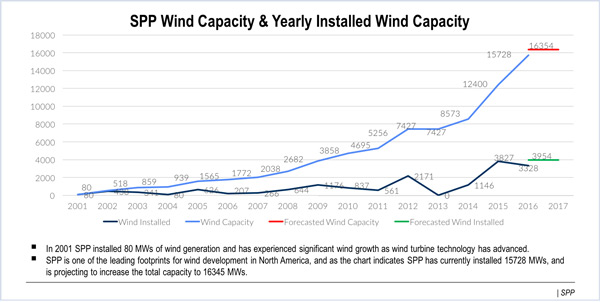By Tom Kleckner
ERCOT may have more wind, but SPP can lay claim to becoming the first North American RTO to obtain more than half of its power from it.
At 4:30 a.m. Sunday, SPP’s footprint generated 11,419 MW of wind energy at the same time its load was 21,919 MW. The wind-penetration mark of 52.1% broke the RTO’s previous record of 48.2%, set last April, and ended a friendly battle with ERCOT to see who could reach the 50% level first.
The two neighboring grid operators sit in the nation’s most wind-rich regions. Texas may top all other states with more than 20 GW of installed capacity — with ERCOT managing more than 17 GW of that — but SPP and its 14-state footprint is not far behind, with more than 16 GW of installed capacity and another 21 GW in the interconnection queue.
In the early 2000s, SPP counted less than 400 MW of wind energy, reporting it as “Other” in its fuel-mix data. Wind now makes up about 15% of the RTO’s nameplate generating capacity, trailing only natural gas and coal generation.
SPP added 4,000 MW of wind capacity in 2016, boosting its maximum simultaneous wind generation peak from 9,948 MW to 12,336 MW. It has set seven peaks for wind generation since last year, the latest coming Feb. 9 at 13,342 MW. Staff has even thrown out a 60% penetration number, saying it expects to crack that level this April.
“Ten years ago, we thought hitting even a 25% wind-penetration level would be extremely challenging, and any more than that would pose serious threats to reliability,” SPP Vice President of Operations Bruce Rew said in a statement. Fifty percent “is not even our ceiling. We continue to study even higher levels of renewable, variable generation.”
Several stakeholder groups are already at work trying to determine how best to add even more wind to SPP’s 550,000-square-mile footprint. The RTO has approved more than $10 billion in transmission infrastructure over the last decade, much of it to connect rural, isolated Midwest wind farms to distant population centers. (See “Stakeholders Try to Grasp Wind Energy’s Implications,” SPP Board of Directors/Members Committee Briefs.)
The RTO is holding a two-day Variable Generation Integration Workshop this week at its corporate headquarters in Little Rock, Ark. Staff will provide a deep dive on the second analysis it has performed on variable generation resources during the last several years. The study focused on system requirements needed to operate reliably at higher penetration levels while calling on fossil fuel resources to compensate for drops in wind production.
“If we start pushing 12 to 15 GW of output, we’re at the point where we should be concerned,” SPP’s Casey Cathey, manager of operations analysis and support, told the Markets and Operations Policy Committee last month. “We’re not trying to say the sky is falling, but it’s important we have a grip on the traditional resources and that we leverage them, as opposed to manually pushing more resources online in case the wind drops.”





